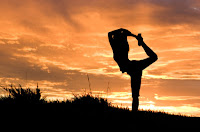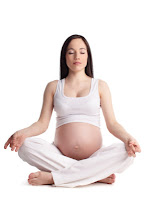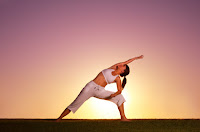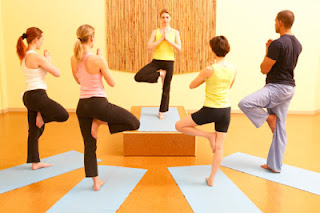Yoga…the ancient Indian world for “union of mind and body”…is far more
than a physical fitness regimen. Despite
its current Western trend of asanas (poses) for fitness, weight management and
agility, Yoga is really about calming the mind and experiencing a divine union
with all that is.
I would like to focus on the benefits of Yoga for
depression, anxiety and stress reduction.
Before I delve into my studies and information, I would like to simply
give the names of a few poses that are, in themselves, indications of the
purpose they are supposed to fulfill.
Warrior Pose: for confidence
and strength.
Cat Pose: for bringing awareness to the breathing which is usually in short supply when one is anxious.
Corpse Pose: for calming, relaxing and balancing the body and mind.
Combinations of asanas can be used for specific conditions and states of mind, body and spirit.
Cat Pose: for bringing awareness to the breathing which is usually in short supply when one is anxious.
Corpse Pose: for calming, relaxing and balancing the body and mind.
Combinations of asanas can be used for specific conditions and states of mind, body and spirit.
I would like to quote Miriam Austin from her book “Cool
Yoga Tricks”:
“It is important to let your body be your guide. Yoga awakens the body’s intelligence and as you continue to practice, you become more and more discerning as to what is right and what is wrong for you and your individual needs. Trust your body, trust your intuition, and trust yourself.” –Miriam Austin
“It is important to let your body be your guide. Yoga awakens the body’s intelligence and as you continue to practice, you become more and more discerning as to what is right and what is wrong for you and your individual needs. Trust your body, trust your intuition, and trust yourself.” –Miriam Austin
During anxiety and worry, the body initiates a
state of “fight or flight”. An increase
in heart rate and blood pressure, excessive perspiration, pressured speech or
becoming tongue –tied, just to name a few symptoms; a do-or-die state of mind.
Perhaps thousands of years ago that was a hunter/gatherer experience left to
the tribal heads; now we experience those same states daily…meeting deadlines
and trying to live up to societies expectations and demands for perfection.
Childs Pose or Balasana is perhaps the most comforting of
the Yoga asanas. It can bring a sense of
feeling grounded, peace, and a surrender that embraces humility and evokes a
quietness of mind, body and spirit. In
almost every Yoga practice we are told (or teach) that when you feel
overwhelmed by an asana (frustration with performing the asana correctly, loss
of breath), simply going into Balasana will bring about rest and calm, as well
as a resurrected sense of physical, emotional, spiritual prowess.
“Doing
Yoga on a regular basis is known as a Yoga practice. Because it is a practice
you don’t have to be perfect.”—Miriam Austin
By creating a Yoga practice that focuses on alleviating
anxiety and worry, we once again awaken a desire to join forces with our own
essential good and reestablish an internal sanctuary and conscious co-creation
with the universe. Since the concept of competition is ultimately foreign to
the practice of Yoga, those that are dealing with anxiety around being
“perfect” in the eye of society or the eyes of their peers can eventually leave
that particular anxiety at the door; Yoga is not biased, the practice does not
judge. Yoga simply allows you to be unified wholly with “you” as an individual.
What a gift to embrace the uniqueness of
who we each are, releasing the Western ideas of perfection, flawlessness and
plastic to cover, fill and erase time and life’s authentic journey.
In fire-walking traditions they say to walk the coals you
have to have both fear and faith. We have taken fear on in our “internal
battlefields” and have led ourselves down an endless road of “I’m not good enough”. It has
extinguished our internal flame. We no longer walk through anything; we run,
race, worry and hurry through nearly every moment of every day.
Yoga and mindful breathing are the very essence of stress reduction caused by this every day “race”. It is the very core of our being-ness and with it we can reclaim and rebalance our mind-body-spirit connection. We took our first breath as babies and will take our last breath as elders…and with this exit of Prana, energy, life-force, we cease to exist. The breath is powerful…it is the founding mother of the practice of Yoga. With breath we are fully alive and connected to the soul. With breath we can embrace or release that which serves or in some cases no longer serves the body (stress, anxiety, depression, etc.). By embracing breath and asanas we gently and uniquely begin the journey back to ourselves. The mind flows, the heart opens to emotional healing and the spirit reconnects us to a state of absolute love and peace. With that comes the capacity to feel and deeply connect with people around us.
Yoga and mindful breathing are the very essence of stress reduction caused by this every day “race”. It is the very core of our being-ness and with it we can reclaim and rebalance our mind-body-spirit connection. We took our first breath as babies and will take our last breath as elders…and with this exit of Prana, energy, life-force, we cease to exist. The breath is powerful…it is the founding mother of the practice of Yoga. With breath we are fully alive and connected to the soul. With breath we can embrace or release that which serves or in some cases no longer serves the body (stress, anxiety, depression, etc.). By embracing breath and asanas we gently and uniquely begin the journey back to ourselves. The mind flows, the heart opens to emotional healing and the spirit reconnects us to a state of absolute love and peace. With that comes the capacity to feel and deeply connect with people around us.
“Through the practices of yoga,
we discover that concern for the happiness and well-being of others, including
animals, must be an essential part of our own quest for happiness and well-being.
The fork can be a powerful weapon of mass destruction or a tool to create peace
on Earth.” –Sharon Gannon
My favorite Yogic breathing exercise is Breath of Joy.
Not only is this a great energizer for any Yoga practice, Breath of Joy is very
beneficial in dealing with depression and anxiety...it counters the shallow
upper chest breathing of anxiety by inviting the breath to completely fill the
lungs. The strong inhalations and arm movements awaken every cell…increasing
oxygen levels in the bloodstream, stimulating the sympathetic nervous system,
circulating more Prana, while the abrupt exhale detoxifies the body and
releases pent up tension.
Genuine happiness breaks the floodgates of depression and
anxiety locked behind years of guarded, fearful suppression. This kind of
genuine happiness can be found through the practice of Yoga and breathing. A
conscious connection with yourself, through the practice of daily Yoga, has
been proven by Yogis for thousands of years to be a way to access total
well-being, freedom from chaos, and direct access to life’s mystery. Western
science has now followed suit in its endless studies to understand the
body-mind connection. The documented
scientific proof revealing the correlation of Yoga and wellness to the
alleviation of physical and emotional pain to the body is insurmountable.
As I incorporate the practice of Yoga into my daily life,
I witness firsthand the transformation of body, mind, and emotional well-being.
Yoga is my reset button...my own tropical vacation to the pristine beaches of personal
unity with myself and a higher power. It brings me great joy to know that I can
be part of the bigger picture, teaching and guiding others on the journey to a
happier, more mindful way of living.








